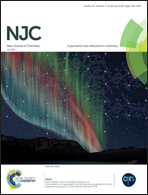A cyanide-triggered hydrogen-bond-breaking deprotonation mechanism: fluorescent detection of cyanide using a thioacetohydrazone-functionalized bispillar[5]arene†
Abstract
A novel sensor (AHP5) comprising a thioacetohydrazone-bridged bispillar[5]arene was developed and shown to fluorescently sense cyanide ions. The sensor manifested a response specific to cyanide over other common anions (SCN−, AcO−, HSO4−, H2PO4−, I−, Br−, ClO4−, Cl−, and F−) in DMSO/H2O (9 : 1, v/v) solution. Upon treatment with cyanide, AHP5 exhibited a significant fluorescence response accompanied by marked changes in its fluorescence spectra. Furthermore, competitive anions had no obvious influence on the probing behavior. Notably, investigation of the recognition mechanism indicated that AHP5 recognized CN− through a deprotonation procedure accompanied by the breaking of intermolecular hydrogen bonds. Furthermore, the sensor was successfully applied to the detection of cyanide in cyanide-containing water samples.
![Graphical abstract: A cyanide-triggered hydrogen-bond-breaking deprotonation mechanism: fluorescent detection of cyanide using a thioacetohydrazone-functionalized bispillar[5]arene](/en/Image/Get?imageInfo.ImageType=GA&imageInfo.ImageIdentifier.ManuscriptID=C7NJ03937A&imageInfo.ImageIdentifier.Year=2018)


 Please wait while we load your content...
Please wait while we load your content...